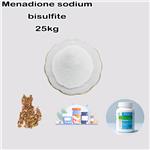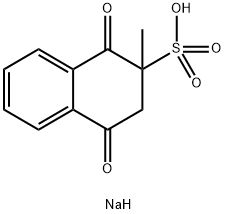Menadione Sodium Bisulfite: Redox Mediation, Plant Protection & Melanin Inhibition
Menadione sodium bisulfite is a water-soluble form of menadione, which belongs to the Vitamin K class of compounds. These are necessary for the biosynthesis of prothrombin and other blood clotting factors. Menadione is a prothrombogenic compound and is used as a model quinone in cell culture and in vivo investigations. Menadione has been shown to affect gap-junctional intercellular communication by mediation of tyrosine phosphorylation. Menadione has demonstrated cytotoxic activity against a variety of cell lines and can induce apoptosis in cultured cells, such as osteoclasts and osteoblasts, via elevation of peroxide and superoxide radical levels. An HPLC method for detection of menadione sodium bisulfite in multivitamin formulations has been published. A chemiluminescence assay for menadione sodium bisulfite in pharmaceutical preparations and biological fluids has been reported. Menadione sodium bisulfite has been used: as a priming agent in tomato for improving salt tolerance; to induce reactive oxygen species (ROS) in human lung epithelium BEAS-2B microtissues; to induce endogenous superoxide production in mouse C17.2 neural stem cells.

Different characteristics between menadione and menadione sodium bisulfite
The electron transfer between intracellular redox systems and extracellular redox mediators has been applied to the detection of cell viability such as bacteria, yeast and mammalian cells. The extracellular redox mediators are required to diffuse into cells and to be reduced by intracellular redox systems. Membrane-permeant menadione is known to be reduced by NAD(P)H:quinone oxidoreductase utilizing both NADH and NADPH as electron donors in the cells. Thus, the efficiency of electron transport by menadione depends on both the activity of NAD(P)H:quinone oxidoreductase and the intracellular NAD(P)H concentration. On the other hand, hydrophilic menadione sodium bisulfite (MSB) has been proposed not to be superior to menadione because of low efficiency of electron transport of MSB. As mentioned above, menadione has been known to be superior to MSB as redox mediator in spite of the demerit that menadione causes the oxidative stress. However, this study demonstrated that MSB was superior to menadione as redox mediator for electron transfer from yeast cells to anode because Menadione sodium bisulfite promoted the stable electron transfer without oxidative stress compared to menadione. This study discussed the effects of menadione and MSB on the production of AOS, oxidation of NAD(P)H, the cell proliferation and the electron flow to anode in order to clarify the effectiveness of MSB as harmless redox mediator.[1]
Reduction of menadione and Menadione sodium bisulfite by NAD(P)H is considered to be catalyzed by NAD(P)H:quinone reductase. This enzyme is a flavoprotein catalyzing two-electron reduction of quinones to hyroquinones, using either NADH or NADPH as electron donor. Hydroquinone is considered to be produced without the accumulation of a dissociated semiquinone. According to this mechanism one-electron reduction of dissolved oxygen by menadiol might generate superoxide anion. Hydrogen peroxide might be generated by dismutation of superoxide anion and/or two-electron reduction of dissolved oxygen by menadiol. From the above results and discussion, this study is summarized as follows. Menadione is membrane-permeant redox mediator and can’t keep the stable electron transfer from yeast cells to anode by promoting both the production of AOS and oxidation of NAD(P)H. On the other hand, Menadione sodium bisulfite is non membrane-permeant redox mediator and mediates the stable electron transfer from yeast cells to anode rather than the production of AOS after reduction of MSB by plasma membrane redox system. The above different characteristics between menadione and MSB acting as redox mediators will contribute to the studies on mitochondrial diseases and cancer therapy.
Menadione Sodium Bisulfite-Protected Tomato Leaves against Grey Mould
Deficiency of vitamin C in Arabidopsis plants resulted in enhanced disease susceptibility to A. brassicicola infection suggesting an active role of ascorbic acid during the plant immunity response. Vitamin K3 is one of fatsoluble vitamin groups and often applied to fungi and plants as a form of water-soluble menadione sodium bisulfite (MSB). MSB had in vitro antifungal activity against a variety of phytopathogenic fungi such as Alternaria alternata, Fusarium graminearum and Ustilago maydis . Stem canker, fungal disease caused by Leptosphaeria maculans, could be controlled in oilseed rape plants locally and systemically by MSB pretreatment via pathogenesis-related protein 1 (PR1) and ascorbate peroxidase (APX) gene expressions showing MSB-enhanced plant defences. MSBregulated hydrogen peroxide accumulation and defencerelated gene transcription in Arabidopsis plants suggested that MSB can modulate defence-associated metabolisms in response to pathogen invasions as well as environmental stresses. Indeed, Menadione sodium bisulfite can confer enhanced tolerance to Arabidopsis plants to deal with environmental stresses such as high salinity via controlling genes associated with proline metabolism. These results suggest that MSB can be applied to crops as a priming agent to cope with pathogen attacks as well as adverse environmental conditions.[2]
Menadione sodium bisulfite-mediated grey mould protection was dependent on inoculum density and tomato leaf position. By both low and high inoculum densities, lesion diameters in the mockpretreated leaves were decreased as leaves were younger in our present study. In contrast, grey mould in tomato stems less developed in basal parts of tomato plants compared to middle and top parts. Leaf agedependent grey mould development was also found in strawberry leaves, and the plant basal immunity was highly correlated with biochemical changes including H2O2, total flavonoids and ascorbate peroxidase activity in different leaves. Biochemical changes in tomato leaves of different ages with and without Menadione sodium bisulfite pretreatment will provide basis on age-dependent plant immunity against B. cinerea infection. It will be interesting to decipher defencive role of ethylene generated by MSB-mediated SlACO1 gene expression, because ethylene may play roles positively or negatively during the tomato grey mould lesion development depending on different ambient conditions. SlPR1a, SlPR1b, SlChi3, and SlChi9 encode different putative antimicrobial peptides, and we cannot exclude that possibility that B. cinerea invading tomato leaf tissues can be directly limited by these antimicrobiol peptides induced by MSB pretreatment.
Menadione Sodium Bisulfite Loaded Rhamnolipid Based Solid Lipid Nanoparticle
A global class of biological pigments is melanin. Various enzymes in a complicated chemical procedure synthesize melanin in epidermal melanocytes. The most important enzyme in the stage of synthesizing melanin is tyrosinase. The most significant grievances of the skin include freckles and melasma, which are pigmentation disturbances generated via the unnatural distribution of melanocytes. Therefore, this irregularity in pigmentation can lead to psychological and social problems in patients. A series of skin lighteners are considered to treat hyperpigmentation disturbance because they can prevent melanin synthesis. Menadione sodium bisulfite (MSB)—one of the derivatives of menadione (vitamin K3)—can considered as a skin-lightener agent due to its ability to inhibit the synthesis of melanin as a result of decreased tyrosinase activity.[3]
The optimized nanoparticles showed an average particle size, zeta potential, polydispersity index (PDI), and drug entrapment efficiency of 117.26±1.12 nm, -6.28±0.33 mV, 0.262±0.002, 83.34±0.75% respectively in hydrophilic-lipophilic balance (HLB) of 12. The in vitro diffusion process demonstrated that MSB-SLN gel had a prolonged release pattern. The levels of Menadione sodium bisulfite in the cutaneous layers (52.192±2.730% or 961.59±50.313 μg/cm2) and the receiver compartment (23.721±1.803 % or 437.049± 33.236 μg/cm2) for the MSB-SLN gel was higher than MSB simple and showed no cutaneous irritancy and toxicity in rats. MSB-SLN inhibited melanin formation and was remarkably higher than free MSB. MSB-SLN inhibited L-3,4- dihydroxyphenylalanine (L-DOPA) auto-oxidation to a greater extent (95.14±1.46%) than MSB solution (72.28±0.83%).
References
[1]Yamashoji S. Different characteristics between menadione and menadione sodium bisulfite as redox mediator in yeast cell suspension. Biochem Biophys Rep. 2016 Mar 21;6:88-93. doi: 10.1016/j.bbrep.2016.03.007. PMID: 28955867; PMCID: PMC5598221.
[2]Jo YS, Park HB, Kim JY, Choi SM, Lee DS, Kim DH, Lee YH, Park CJ, Jeun YC, Hong JK. Menadione Sodium Bisulfite-Protected Tomato Leaves against Grey Mould via Antifungal Activity and Enhanced Plant Immunity. Plant Pathol J. 2020 Aug 1;36(4):335-345. doi: 10.5423/PPJ.OA.06.2020.0113. Erratum in: Plant Pathol J. 2021 Apr;37(2):204. doi: 10.5423/PPJ.ER.06.2020.0113. PMID: 32788892; PMCID: PMC7403521.
[3]Asadpour Panbehchouleh F, Amani H, Saeedi M. Menadione Sodium Bisulfite Loaded Rhamnolipid Based Solid Lipid Nanoparticle as Skin Lightener Formulation: A Green Production Beside In Vitro/In Vivo Safety Index Evaluation. Adv Pharm Bull. 2024 Oct;14(3):623-633. doi: 10.34172/apb.2024.047. Epub 2024 Jun 22. PMID: 39494253; PMCID: PMC11530874.
You may like
See also
Lastest Price from Menadione sodium bisulfite manufacturers

US $0.00-0.00/kg2025-05-28
- CAS:
- 130-37-0
- Min. Order:
- 1kg
- Purity:
- 95%min;medical grade and feed grade
- Supply Ability:
- 500kg

US $0.00/KG2025-04-15
- CAS:
- 130-37-0
- Min. Order:
- 1KG
- Purity:
- 99%
- Supply Ability:
- 500000kg


